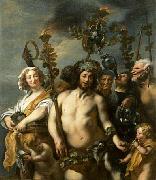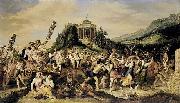Wholesale Oil Painting No Minimum |
|||||||||||
|
|
|||||||||||

|
|||||||||||
|
|
|
||||||||
Maerten van heemskerckDutch Northern Renaissance Painter, 1498-1574 Dutch painter, draughtsman and print designer. He was among the second generation of Netherlandish artists to travel to Italy, where he was profoundly affected by the work of contemporary artists in Rome and by the examples of Classical sculpture to be seen in the city (see ROMANISM). On his return to the north, van Heemskerck had a long and successful career. His extensive oeuvre (over 100 paintings) comprises large altarpieces, portraits and smaller works (with both religious and mythological subjects). He also produced a vast number of drawings for prints. He helped spread the influence of Michelangelo and Giulio Romano in the northern Netherlands, through his strong, monumental style, with much emphasis on anatomical detail. He was thus an important figure in the dissemination of late Mannerism in northern Europe |
||||||||
|
|
||||||||
Triumph of Bacchus
Triumph of Bacchus Painting ID:: 39643 |
mk150
c.1537/7
Oak
56.3x106.5cm
mk150 c.1537/7 Oak 56.3x106.5cm |
|||||||
|
|
||||||||
Jacob JordaensFlemish Baroque Era Painter, 1593-1678 Jacob Jordeans was born on May 19, 1593, the first of eleven children, to the wealthy linen merchant Jacob Jordaens Sr. and Barbara van Wolschaten in Antwerp. Little is known about Jordaens's early education. It can be assumed that he received the advantages of the education usually provided for children of his social class. This assumption is supported by his clear handwriting, his competence in French and in his knowledge of mythology. Jordaens familiarity with biblical subjects is evident in his many religious paintings, and his personal interaction with the Bible was strengthened by his later conversion from Catholicism to Protestantism. Like Rubens, he studied under Adam van Noort, who was his only teacher. During this time Jordaens lived in Van Noort's house and became very close to the rest of the family. After eight years of training with Van Noort, he enrolled in the Guild of St. Luke as a "waterscilder", or watercolor artist. This medium was often used for preparing tapestry cartoons in the seventeenth century. although examples of his earliest watercolor works are no longer extant. In the same year as his entry into the guild, 1616, he married his teacher's eldest daughter, Anna Catharina van Noort, with whom he had three children. In 1618, Jordaens bought a house in Hoogstraat (the area in Antwerp that he grew up in). He would then later buy the adjoining house to expand his household and workspace in 1639, mimicking Rubens's house built two decades earlier. He lived and worked here until his death in 1678. Jordaens never made the traditional trip to Italy to study classical and Renaissance art. Despite this, he made many efforts to study prints or works of Italian masters available in northern Europe. For example, Jordaens is known to have studied Titian, Veronese, Caravaggio, and Bassano, either through prints, copies or originals (such as Caravaggio's Madonna of the Rosary). His work, however, betrays local traditions, especially the genre traditions of Pieter Bruegel the Elder, in honestly depicting Flemish life with authenticity and showing common people in the act of celebratory expressions of life. His commissions frequently came from wealthy local Flemish patrons and clergy, although later in his career he worked for courts and governments across Europe. Besides a large output of monumental oil paintings he was a prolific tapestry designer, a career that reflects his early training as a "watercolor" painter. Jordaens' importance can also be seen by his number of pupils; the Guild of St. Luke records fifteen official pupils from 1621 to 1667, but six others were recorded as pupils in court documents and not the Guild records, so it is probable that he had more students than officially recorded. Among them were his cousin and his son Jacob. Like Rubens and other artists at that time, Jordaens' studio relied on his assistants and pupils in the production of his paintings. Not many of these pupils went on to fame themselves,however a position in Jordaens's studio was highly desirable for young artists from across Europe. |
||||||||
|
|
||||||||
|
|
Triumph of Bacchus
Triumph of Bacchus Painting ID:: 88583 |
c. 1645(1645)
Medium Oil on canvas
cjr c. 1645(1645) Medium Oil on canvas cjr |
||||||
|
|
||||||||
Frans Francken IIFlemish Baroque Era Painter, 1581-1642 was a Flemish Baroque painter and the best-known member of the large Francken family of artists. Many of his works are small historical, allegorical and biblical cabinet paintings with the focus on figures. He also invented or popularized several new themes that became popular in Flemish painting, such as genre scenes populated by monkeys (later imitated by David Teniers the Younger) and Kunstkamer paintings displaying a wealth of natural and artistic treasures against a neutral wall. Francken frequently collaborated with other artists, adding figures to works by Tobias Verhaecht and Abraham Govaerts. |
||||||||
|
|
||||||||
|
|
Triumph of Bacchus
Triumph of Bacchus Painting ID:: 89491 |
first half of 17th century
Medium oil on oak panel
cyf first half of 17th century Medium oil on oak panel cyf |
||||||
|
|
||||||||
|
Frans Francken II Flemish Baroque Era Painter, 1581-1642 was a Flemish Baroque painter and the best-known member of the large Francken family of artists. Many of his works are small historical, allegorical and biblical cabinet paintings with the focus on figures. He also invented or popularized several new themes that became popular in Flemish painting, such as genre scenes populated by monkeys (later imitated by David Teniers the Younger) and Kunstkamer paintings displaying a wealth of natural and artistic treasures against a neutral wall. Francken frequently collaborated with other artists, adding figures to works by Tobias Verhaecht and Abraham Govaerts. Triumph of Bacchus first half of 17th century Medium oil on oak panel cyf |
||||||||
|
|
||||||||
|
Prev Next
|
||||||||
|
|
||||||||
|
Related Paintings to Frans Francken II :. |
||||||||
|
|
||||||||
|
CONTACT US |



